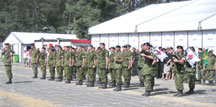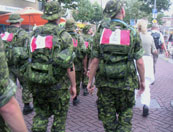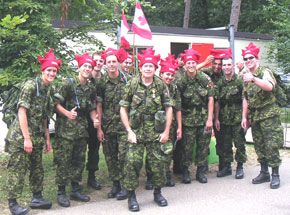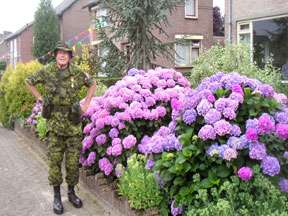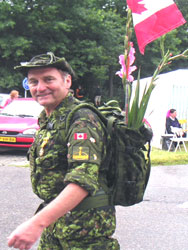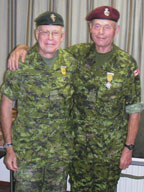|
|
| Issue 021/2005 |
|
The
Canadian Honour Guard raising the Canadian flag shortly after CF
teams arrival in camp. This year the RMC Team was picked to be the honour guard. |
This photo has the RMC marching smartly through the town of Grosbeek just before passing the reviewing stand and saluting the Burgomaster. The RMC flags on the team members rucksacks and the team's deportment throughout the Marches enhanced the image of the College. |
|
This photo shows the RMC at the end of the first day. Murray marched the last leg that day with the team. Teams finish by marching into the International Beer Tent and "making a statement" as they halt and are assessed by other teams with loud cheers of boos. The RMC Team got rave notices. The photo shows their preparation for their finish. |
This photo shows the route going through a town. Marchers are encouraged to enjoy the scenery along the way and, most importantly, stop for a moment and talk with citizens along the way. Interestingly enough the Dutch know a lot about Canada and many have visited it. |
|
Senator Day striding along wearing his Nijmegen Medal earned in 2003. Note his "Parliamentarian" armlet. The Gladiola is the official emblem of the Nijmegen Marches and many marchers, including the Senator, are given some by citizens along the way. |
We two septuagenarians have completed the Marches five times each mainly as Senior Citizens. |
|
(cont'd) Memories of Nijmegen 2005 go far beyond the blisters Moments like that marked Nijmegen 2005—a journey that went far beyond the blisters to the very hearts of the marchers. In all, 220 CF members participated in the 89th Nijmegen Marches, a strenuous 160-kilometre military march, which ran from July 19 to July 22. Col Johnston, originally from Winnipeg, now calls Ottawa home.At 72, he was not even the oldest Canadian marcher. While that distinction went to 76-year-old Chief Warrant Officer (Ret) Jack de Bruijne the Royal Canadian Legion representative, Col Johnston says he hoped he could still offer CF members inspiration. “The first challenge,” he says with a laugh,“is getting from one rest stop to the other.” The second, though, came way before he ever set foot in the Netherlands: the training. Also marching for the fifth time was CWO de Bruijne. And why? He says it was a unique opportunity to work with younger military personnel. Plus, he adds, “There was no hockey.” As for the welcome they received, he says it was enthusiastic.“They were elated to see Canadians marching through cities and towns.” And the crowds lining the route were impressive. At one point, he says the Canadian teams literally had to push themselves through the throngs of people. “With that energy, you don’t have to walk,” he says.“It propels you through.” Lieutenant-Commander Michel Audy is a Reservist at HMCS Montcalm in Québec City. A member of a joint Navy Reserve and Chief of the Maritime Staff Team, they never had the opportunity to march together.And, in fact, only met each other for the first time on the plane. The team soon gelled and on the second day, had shaved half an hour off their time. En route to the Netherlands, the Canadian contingent visited the Canadian National Vimy Memorial Park in France, a visit sponsored by the Royal Canadian Legion. LCdr Audy says Vimy is eerily quiet and calm, a marked contrast to the death and devastation once wreaked there. Of the crowds in the streets, he also says Canadians receive a special welcome and sometimes some much needed sustenance.One onlooker even pressed a glass of beer into his hand. Master Corporal Angeline Mooney is the chief clerk or “scribe” on HMCS Victoria. Despite 19 years in the Air Force, she had never had the opportunity to do Nijmegen. So 2005 she decided, in the Year of the Veteran and the 60th anniversary of the end of the Second World War, would be her year. During the contingent’s visit to the Canadian War Cemetery in Groesbeek, she had a special task. Armed with a VE Day nickel, she planned to lay it on a Canadian grave. Initially, she chose any fallen soldier, but then learned that a colleague’s great uncle was buried there. It would be his grave that she searched for—among the many—to bring a piece of thanks and Canada to the young man who lost his life at 19. |

